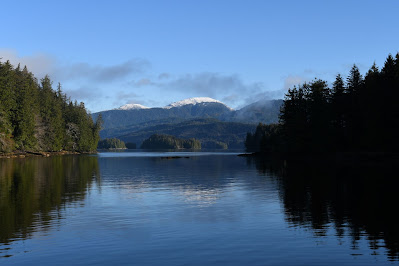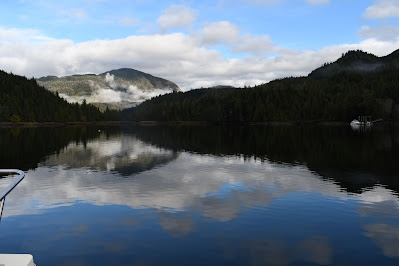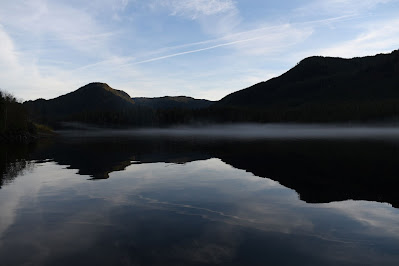First trip of 2023, WooHoo!
I had not been out since the Naha day trip on Dec 3rd.
I went south for the holidays and was out of town for 3 weeks. On Dec 31st there was a boat fire on the boat directly behind me. Thankfully there was no damage to my boat, but it scary nevertheless until I got back and could check it out myself.
I am running the City League basketball program right now, and we play games on Sunday, Tuesday and Thursday and that sort of limits what days I can get out, especially if I want to stay overnight.
The weather forecast for Friday and Saturday showed rain, but little to no wind, so I scheduled an overnighter to Shelter Cove in Carroll Inlet. It is relatively close to town, and Carroll Inlet is a beautiful area.
Many commercial fishermen have a suspicious nature and will not leave port on a Friday, much less on a Friday the 13th. But I was not about to let that stop me.
I pulled out of my slip at 8 AM just as it was getting light. The forecasts said nothing about fog, but fog there was, in spades!
Here is the view outside my window. I couldn't see anything at all.
In conditions like this I have to rely solely on my equipment, primarily the GPS, AIS, and radar. The GPS shows my location in relation to bodies of land, the AIS shows the presence of larger vessels such as tugboats, ferries, barges, and cruise ships, and the radar shows what is actually out there, most importantly other vessels that are not broadcasting an AIS signal.
My Garmin GPS chart plotter has the ability to split screens, so in conditions like this I usually have the navigational chart on one side and the radar on the other. This is what it looks like.
The thing about radar is that it is not an exact science. My radar set is 15 years old, and I suspect the newer versions are more accurate and faster. The signal "sweeps" around the screen in a circle painting "blips" where it sees land or objects. The thing is that it regular paints blips in error and they disappear in the next sweep or two. So, when I was in close quarters making my way SE through town the radar kept showing these little blips all over the place, and then they would eventually disappear. It makes things a little stressful because you can never really tell whether that little blip is a small boat or just a phantom blip.
On the above image of the radar, I have the range set to look out to only 1 mile, with each ring being a half-mile from the boat. When I am out in more open waters, I increase the range so the radar can see further out.
I made it safely through the congestion of town without hitting anything, but I had to run very slowly because in dense fog like that you cannot see the logs and other debris in the water ahead of the boat.
The fog was dense all the way out to Mountain Point where it opened up briefly. From there until I got to the Shelter Cove USFS dock the fog opened up and closed a few times.
Carroll Inlet is a very beautiful area, and with the fog and mist rising and then dropping again it made for somewhat eerie vistas along my route.
The one thing that is nice about running in fog is that it is almost always flat calm water, and that was definitely the case on this run.
I arrived at the USFS dock at Shelter Cove at a little before noon. It took me longer than usual to get out here because of all the times I had to slow down in the dense fog.
This area is occasionally logged and when there are loggers here the dock is inaccessible to pleasure cruisers like myself. Sometimes they tie a huge barge to the tiny USFS dock. I have heard there is now a road from town out to this location, although I do not know where it originates on the town side. That saddens me because one of the reasons I come here is for solitude. In the summer I anticipate running into pickup truck loads of teenagers with weapons and fireworks.
Here's what the dock looks like as you approach it. It is in a little nook of the shoreline, and you cannot see it until you turn that last corner.
Sometimes there are USFS vehicles parked at the top of the ramp, but none were there on this trip.
The rain was coming and going in spurts, and I took advantage of a brief lull in the rain to jump out and get a selfie of me by the boat.
After a quick lunch I geared up with warm clothes and boots and full rain gear, as by now it was raining pretty hard. I could not use my good Nikon camera in this rain, so I took some shots with my cell phone. I took a short hike up the logging road.
I usually carry my pistol on these hikes but when I went to unlock the trigger lock, I discovered that I had left the keys at home, so no pistol on this walk.
Right at the top of the ramp there was a large patch of glare ice, which I avoided by walking around the edges. I had some ice cleats on the boat, but I don't think they fit over my size 13 Xtra-Tuff boots.
From the logging road I got this photo of the boat at the dock. That's solitude for you.
On the road there was light snow at first, and then it got deeper as I got further up the road. There were tons of deer tracks and also wolf tracks, which was a little disconcerting since I did not have my pistol with me.
These are some of the deer tracks.
This wolf was caught in a trap, and that is why he wasn't running. I knew there were traplines in the area as there was a sign up near the ramp. I felt a little sorry for this guy, but there was nothing I could do for him, so I continued on my walk that day.
I walked on and on up the logging road and the snow got deeper and I started breaking through on every step. I don't have snowshoes, but that would have been the ticket for today. As I got up to the junction in the road I looked down at more miles of snowy road. I cut my walk short and headed back to the boat. This scene reminded me of guitarist Tommy Emmanuel's piece entitled "The Endless Road."
I have gotten crabs in this area in the past, usually setting pots right in front of the dock. On this day I was a little lazy, so I set two crab pots right from the front of the dock. There were no other boats around so that area was clear. I use chopped up herring and parts from salmon carcasses for bait.
I let the pots sit overnight and as soon as it just getting light on Saturday morning I went out and pulled them. In our area for Dungeness crabs they must be males and also be over 6 1/2" wide. In my first pot I got only 1 but it was legal.
In my second pot I got 3, but one of them was way too small to keep. I guess it wasn't actually quite light yet because even with the flash the photo came out pretty dark.
I decided to only keep 2 of the 3 legal crabs I got because the pot I use to cook them can only handle 2 crabs at one time. And since I am alone, 2 crabs were plenty for me.
The next task was to set up my propane crab cooker on the dock. I have been using a stove called a Woodland Power Stove for several years now. I like it because it folds up flat and stores in a nice canvas bag. And it has its own hose that goes to the propane tank.
However, I quickly figured out that my stove was unusable. The storage locker under my flybridge seat occasionally fills with rainwater because the drain hole gets plugged up with dirt. So, the stove and much of my other gear in that locker sat in about a foot of rainwater for a long time, and the valve that controls the flow of propane was non-functional. I'm afraid it is kaput, and it is time for a new crab cooking stove.
Plan B was to pull out my Coleman camp stove. I have an electric stove on board, but it is really wimpy and would probably never boil the big pot of water needed to cook crabs. The Coleman doesn't generate as many BTUs as the Woodland Power Stove, but it's much better than the stove on board.
If anyone is curious, here is how I cook my crabs. I keep the crabs alive in a bucket until just before cooking them. I have read that they have toxins in them and if you butcher them and let them sit for a long time you are danger of getting sick from the toxins.
I use a big pot of sea water and get it to a rolling boil. Then I butcher and clean the crabs and drop them into the pot. Then bring the water to a second boil, and time them for about 12 - 15 minutes.
Lunch!
I wanted to get back to the harbor before dark and so I planned to leave no later than 1 PM. I had a bit of a scare when I went to start my engines. They balked at starting and then my electronic engine controls flashed an error. I had visions of calling the Coast Guard on the radio and getting them to arrange for someone to tow me in.
I thought perhaps the problem was that my starting batteries were low, so I started the generator (which has its own dedicated starting battery) and ran the battery charger for about 20 minutes. When the generator is running it pumps about 85 amps into the batteries. After that I started the engines with no issues and made the run to town.
I arrived into the harbor just a hair before full dark at about 4:10 PM.
Mileage for this trip was 51.6 nm.
I'm already making plans for my next trip!









































































